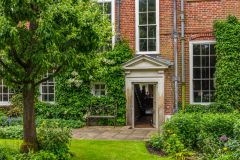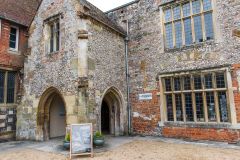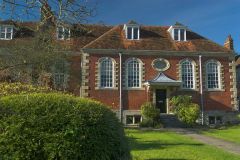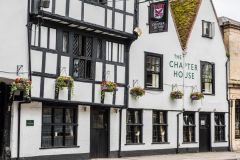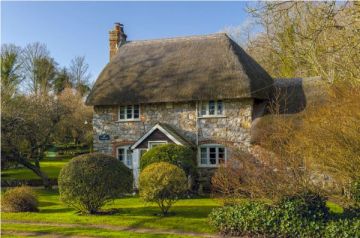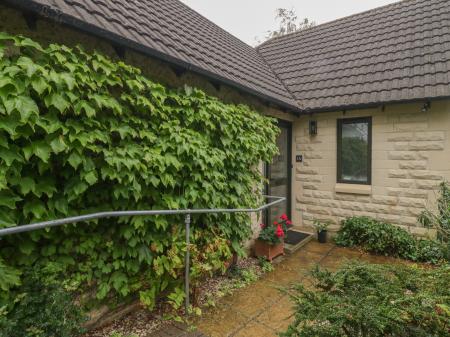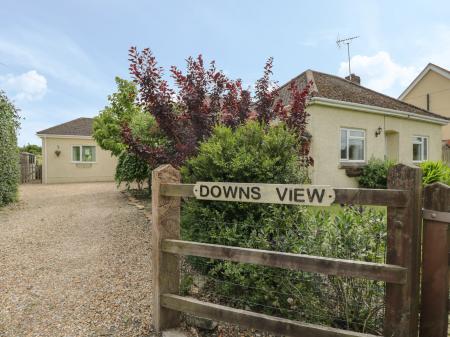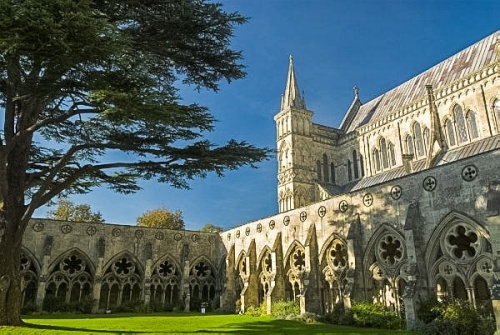
Salisbury Cathedral is unique in Britain. Unlike its cousins, Salisbury did not evolve gradually over centuries, with constant additions and renovations. Rather, it was built nearly to completion within a single generation. As a result, it presents a unity of vision that is remarkable.
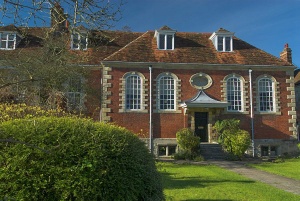
The Cathedral was begun in 1220, and finished, with the exception of the tower and spire, in 1258. Ah, that spire. Constable painted it, and generations of artists with paintbrush or camera have attempted to capture its beauty rising above the water meadows of the River Avon.
At 404 feet, it is the tallest spire in England, a fact known by most schoolchildren. What is not so well known is that the medieval builders of the spire accomplished their masterpiece with foundations only 5 to 6 feet deep in the wet ground to take the strain of 6400 tonnes.
Because of that wet ground, the cathedral has been subject to structural stress over the centuries. In 1668 Sir Christopher Wren was called on to survey the spire. Wren found that it was leaning nearly 30 inches out of plumb, and had iron tie-rods inserted to brace it.
When Wren's braces were replaced some two hundred years later, measurements revealed that no further movement had occurred. It seems that Sir Christopher knew his trade.
The Cathedral is more than the spire, however. An old saying records that there are as many pillars as there are hours in the year, and as many windows as there are days. Many of those pillars are made from beautiful, dark Purbeck Marble, which isn't actually marble but crystalline limestone, and isn't from Purbeck, but from Corfe Castle, Dorset.
The cathedral library houses an original copy of the Magna Carta, brought here by the William Longpre, Earl of Salisbury and half-brother to King John. Longpre is buried in the cathedral, the first person so honoured.
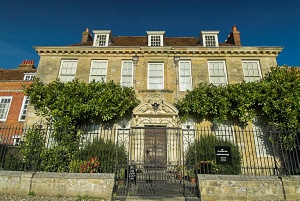
In the nave you can see what is probably the oldest working mechanical clock in the world, dating to 1386. There are no hands and no clock face, rather, it rings a chime of bells every hour. It was originally built to call the bishops to services.
Cathedral Close
Just as there is more to the cathedral than the spire, so there is more to the city than the cathedral. A wide green space, The Close, surrounds the Cathedral.
The Close, essentially a walled city within the city, is ringed by wonderful period houses. The most memorable houses in the Close are Mompesson House, a National Trust property finished in high Georgian style, and Malmesbury House, originally built in 1327, but later remodelled in Georgian fashion also. Then there is Arundells, built in the 14th century but more lately the home of Sir Edward Heath.
Around Salisbury
Beyond the Close, Salisbury repays a day spent wandering. There are numerous beautiful half-timbered buildings, floors tilting like a ship in heavy seas. Try The George, for inexpensive lunches.
The church of St. Thomas a Becket, a former "chapel of ease" for the cathedral, has a magnificent carved and panelled roof, and an organ donated by George III.
The Market Place has seen regular markets since 1227, and it used to be sprinkled with crosses which were centres for selling particular kinds of produce. Nowadays only the Poultry Cross remains.
The Market Square was the scene of the execution of the Duke of Buckingham in 1483. The Duke, in hiding from Richard III, was betrayed when a labourer noticed extra food being delivered to his hiding place.
St. Ann Street is home to beautiful, ivy-covered Georgian and Victorian houses, and the 14th century St. Ann's Gate offers the most scenic approach to the Cathedral Close. George Frederick Handel gave his first performance in England in a room above the Gate.
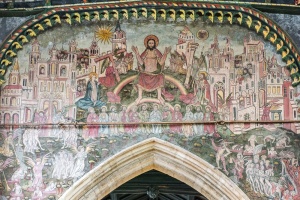
St Thomas church
Beyond Salisbury
Just a few miles north of Salisbury is Old Sarum, site of the original cathedral and castle, contained within steep Iron Age earthworks. Not much of the cathedral remains, but the castle ruins are impressive. A few miles further north lies Stonehenge, the most famous megalithic monument in the world.
If you leave the city heading west instead of north you will quickly find yourself in Wilton, home of the well-known Wilton carpet works, and Wilton House, the residence of the Earls of Pembroke. Wilton House is one of the most impressive stately homes in Britain, and well worth a visit.
Salisbury seems to have escaped the worst ravages of its popularity, and despite the tourists that throng the streets in summer, it retains a relaxed feeling. And the spire still rises over the water meadows that have changed surprisingly little since Constable painted the scene centuries ago.
Highlights:
Salisbury Cathedral - The graceful 13th-century cathedral possesses the tallest spire in Britain
Arundells - a beautiful historic house in the Cathedral Close, the former home of Sir Edward Heath
Harnham Water Meadows - This Environmentally Sensitive Area has a fascinating history and is home to a wide variety of wild creatures.
Mompesson House - One of the houses in the Close, finished in lovely Georgian style.
Old Sarum - Iron Age earthworks surrounding the old cathedral and ruined castle.
Salisbury Museum - this fascinating museum of Salisbury's heritage is
housed in the 13th century King's House, opposite Salisbury Cathedral
Wilton House - One of the finest stately homes in England
About Salisbury
Address: Salisbury,
Wiltshire,
England
Attraction Type: Town
Location map
OS: SU1429
Photo Credit: David Ross and Britain Express
HERITAGE
 We've 'tagged' this attraction information to help you find related historic attractions and learn more about major time periods mentioned.
We've 'tagged' this attraction information to help you find related historic attractions and learn more about major time periods mentioned.
Historic Time Periods:
Find other attractions tagged with:
13th century (Time Period) - 14th century (Time Period) - castle (Architecture) - Christopher Wren (Person) - George III (Person) - Georgian (Time Period) - Iron Age (Architecture) - King John (Person) - Medieval (Time Period) - Richard III (Person) - Victorian (Time Period) -
NEARBY HISTORIC ATTRACTIONS
Heritage Rated from 1- 5 (low to exceptional) on historic interest
Salisbury Museum - 0.3 miles (Museum) ![]()
Arundells - 0.4 miles (Historic House) ![]()
Salisbury Cathedral - 0.5 miles (Cathedral) ![]()
Mompesson House - 0.5 miles (Historic House) ![]()
Old Sarum - 2 miles (Castle) ![]()
Wilton House - 2.9 miles (Historic House) ![]()
Wilton, St Mary's Church - 3 miles (Historic Church) ![]()
Wilton Italianate Church - 3.1 miles (Historic Church) ![]()
Nearest Holiday Cottages to Salisbury:
Salisbury, Wiltshire
Sleeps: 6
Stay from: £1154 - 4422
More self catering near Salisbury


